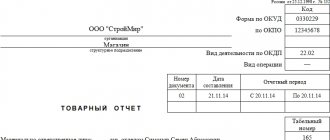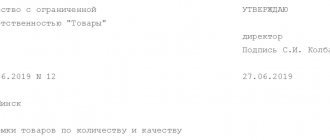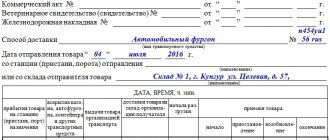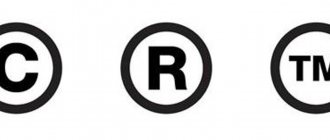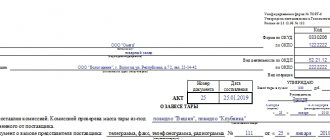Who fills out the TORG-11 form
The product label is filled in at the moment the goods or material assets arrive at the warehouse. Registration is carried out by the person financially responsible for inventory items in the warehouse. Next, the contents of the TORG-11 form are checked by a higher-ranking warehouse employee - manager, senior storekeeper or warehouse worker of another position.
If the indicators of the product label correspond to the actual parameters of the product, the person in question puts a signature, after which the document remains in the place where the valuables are stored. A product label is filled out for each item of product arriving at the warehouse for storage.
| ★ Best-selling book “Accounting from scratch” for dummies (understand how to do accounting in 72 hours) > 8,000 books purchased |
Scope of application TORG-11
Product labels (form TORG-11) are used in warehouses and other places intended for storing goods.
TORG-11 must be located next to the goods, information about which is included in this warehouse document. Completed product labels contain the necessary information about the product that facilitates its search and is used when conducting inventory. Information from the product label is subsequently entered into the inventory list of goods and materials.
You will learn how to fill out an inventory list from the article “Procedure for filling out an inventory list (form)” .
Who signs the TORG-11 product label
The label is signed by the persons who filled out the document and checked the correctness of filling out the document, this could be:
- A manager of a warehouse or other place where goods and materials are located (warehouse manager, store manager);
- A warehouse employee, for example, a storekeeper, financially responsible for a given product;
- Accounting representative.
The signature is placed after checking that the materially responsible person has filled out the TORG-11 form for the goods received at the storage location.
The signed product label is not submitted to the accounting department; the document is needed solely for warehouse accounting of inventory items at storage locations, so the verified and signed document remains in the warehouse.
Recommendations for filling out the TORG-9 form
The form is presented on one page, drawn up on the front side. At the top, the header part is filled with the following data:
- Name of the company selling the product, its address, OKPO code;
- The name of the structural unit is filled in if necessary;
- Type of activity in coded digital designation according to OKDP;
- Type of operation – coding is indicated if available;
- Label number - as a rule, sequential numbering is used throughout the year;
- The date the label was drawn up is based on the fact that the product was packaged in a closed container.
Under the name of the document, fill in the details of the quality certificate for the product - number, validity period. The certificates themselves must be handed over to the buyer along with the goods and other accompanying documentation.
If the product has a limited sale period, it should also be indicated. If there is none, this field does not need to be filled in.
Below is a tabular section that directly provides information on goods packed in closed containers. Filling out the columns in this table is shown in the table:
| Column number | Information to be filled in |
| 1 | Product details:
|
| 2 | The name of the unit of measurement for the specified product is given in abbreviated form in accordance with accepted standards |
| 3 | Quantity of goods according to the specified unit of measurement |
| 4 | Position weight |
The tabular section sequentially lists all commodity values packaged in closed containers, indicating names, main characteristics and quantitative indicators. After filling out the label, the total contents of the container are summarized in the bottom line of the table.
The employee who packed the goods and filled out the TORG-9 label certifies the document with his signature, after which he passes the document to the financially responsible person for verification and certification. The latter makes sure that the formatting is correct and puts his signature, thereby confirming that the given data corresponds to the actual contents of the container.
If a box specification is carried out, then it is enough to issue 2 copies of the TORG-9 packaging label, and then fill out the TORG-10 specification on its basis. If the specification is not written out, then an additional copy of the label is issued to attach it to the shipping documents.
Errors in filling out the product label
The financially responsible person filling out the TORG-11 form must not make mistakes in indicating information about inventory items. It is necessary to provide the most complete information about all items stored on a specific shelf (cell). It is necessary to indicate not only the name, but also detailed individual characteristics of the property (article number, grade, size, etc.).
There should be no errors in indicating quantity and price. The price is determined in accordance with the accompanying documentation, as well as the organization’s procedure for accepting inventory items for accounting. Valuables can be accepted into the warehouse at the purchase price specified by the supplier, or at the selling price, including a trade margin.
Errors in the design of the label will not allow you to correctly fill out the inventory list in the future; therefore, you should carefully fill out the tabular part of the TORG-11 form. The determining factor when filling out the TORG-11 form is the location of the product, so the product label remains in a specific cell (compartment, shelf), therefore, it is allowed to include all the names that are in a given cell in one form.
Since the product label is used when filling out the INV-3 inventory list, the signature of the person who verified the completion of the TORG-11 form is required. By putting his signature, the manager of a warehouse or other storage location confirms that all information is correct, and the volume of inventory items that is reflected in the product label is actually stored in this location.
The label must be signed not only by the employee who checked the correctness of registration, but also by the materially responsible employee who filled out the document. Only if the specified signatures are available, the product label data can be used to fill out inventories when taking inventory of goods and materials.
Rules for filling out product labels
TORG-11 is filled out by the storekeeper in a single copy for each item of goods. By signing the label, the warehouse manager guarantees that all information specified in the document is accurate.
The label indicates its serial number and date of compilation. In this case, it is also necessary to maintain a log of the specified warehouse documents.
Based on the fact that the label must be included with the product, it is possible to indicate several items of goods and materials on it if they are stored in 1 cell in the warehouse. The final part of the table shows the total number of goods stored in the warehouse and labeled.
The tabular part of the document contains information about the name of goods and materials, units of measurement, quantity, article number, size, etc. The document also contains the accounting price of the product (this can be a sales or purchase price).
Read about the features of accounting for goods in trade in the article “Trading goods with and without VAT (nuances)” .
Errors in filling out the TORG-9 form
The packaging label must include sufficient information to identify what is packaged in the closed container and in what quantity. Errors may be due to insufficient information provided. The label must include all items packaged in containers; for each item, explanatory information regarding the name, characteristics and quantitative values must be provided. Only information presented in full will identify possible deficiencies.
It is also mandatory to fill in the fields indicating data on certification documents. If a sale period is set for goods, then it must be written down in the TORG-9 form. Lack of information about the validity period of the certificate and the period of sale of goods will be an unacceptable error. Moreover, the certificate data indicated in the label must clearly correspond to the actual data of the attached certificates. There shouldn't be any discrepancies.
The document will be filled out with an error if there are no certification signatures. The completed TORG-9 form must be signed by the person who actually packed the goods in the container. In addition, the label must be checked by the financially responsible person. By signing the label, MOL takes responsibility for the correctness of the information provided. Possible errors and discrepancies will be queried from the signatories of the document.
Recommendations for filling out the form
The main purpose of the TORG-9 form is to indicate the characteristics and quantity of goods contained in a closed container. This will allow the recipient of the product to check the compliance of the cargo with the accompanying documentation without unpacking.
Packing label sample:
- contains detailed information about the characteristics of the product and its quantity;
- reflects the exact data of the product certificate;
- informs about the timing of the sale of goods;
- filled in completely;
- signed by the employee who directly packaged the goods and the financially responsible employee (if these responsibilities are not assigned to one person, in such a situation only his signature will be sufficient).
Upon completion of packaging the goods, the employee fills out the TORG-9 form. At the end, he puts his signature and full name, then the form is handed over to the financially responsible person for verification. After making sure that the data is correct, he signs the form.
Important! For each location in the warehouse, three copies of the packaging label are issued.
Form TORG-9 is filled out in triplicate. One of them is attached to the invoice, the second is placed directly in the container, the third remains in the warehouse. The first copy will be stored in the buyer’s accounting department, and the remaining copy in the warehouse will be stored in the supplier’s accounting department.
The procedure for filling out the packaging label is different for box certification. In this case, it is drawn up in two copies, and a specification in the TORG-10 form is attached to the accompanying documentation.
Procedure for filling out the TORG-1 form
The TORG-1 form consists of a title page, a tabular part (occupies the 2nd and 3rd pages) and a final part.
On the title page you must indicate:
- Information about the consignee company.
- Name and details of the basis document.
- Number and date of compilation.
- Place of acceptance of goods and materials.
- List of accompanying documents and their details.
- Information about the shipper, manufacturer, supplier.
- Information about the insurance company.
- Details of the supply agreement, invoice and some other documents.
- Delivery method, dispatch date.
At the bottom of the title page there is a small table indicating the date and time:
- arrival of goods to the organization;
- start of acceptance of goods;
- suspension and resumption of acceptance;
- completion of acceptance of goods and materials.
On the 2nd page in the table you must indicate the data on the supplied products declared by the supplier (name, grade, unit of measurement, price, quantity). Information about the certificate is also entered here; it must be part of the accompanying documentation.
On the 3rd page, the consignee displays the actual data on received goods and materials, the amount including VAT and the VAT itself. Then you need to register the identified deviations. Below the table you should put a note about the condition of the goods and packaging. Next, you need to indicate a conclusion about the reasons for the shortage, if any.
On page 4 of the TORG-1 act, the composition of the commission and its conclusion are indicated. In the conclusion, it is stated whether the received goods and materials correspond to the shipper’s documents, and a decision is made on what to do next with the goods: capitalize or take other measures.
If a representative of the supplier was present, indicate his full name, position and document certifying his authority. Below is the decision of the head of the organization. The act is signed by the chief accountant and the warehouse manager (or storekeeper). No printing is required on the document. Below you can download TORG-1: form and example of filling out the form.
Rules for drawing up the TORG-4 act
In order to register TORG-4, you will need to collect a commission. It must include an employee who is financially responsible for the safety of incoming goods. It is to this person that the goods will be transferred in quantity. Also, a representative of the supplier must also be included in the commission.
The act is drawn up in 2 identical copies, the 1st of which is sent to the accounting department, and the 2nd is kept by the person financially responsible for the goods. The act must be signed by all members of the commission, and the approval stamp must be affixed on the first page by the head of the recipient of the goods and materials.
When filling out the TORG-4 act for the first time, many may have a lot of questions. For example, not everyone will immediately guess what should be indicated in the “Weight of station goods” column. It must indicate the weight of the cargo, determined first at the departure station and then at the arrival station.
The column “Packaging Condition” must be filled in without fail. If the cargo arrives in a whole package, it is marked with the words “Undamaged”; if there is something wrong with the package, then its condition is described in detail. In column 3 of the tabular part, the characteristics of the goods must be described in accordance with Art. 10 of the Law “On Protection of Consumer Rights” dated 02/07/1992 No. 2300-I .
For other nuances of goods acceptance, read the material “What must be included in the goods acceptance certificate (form)?” .
Is it always necessary to draw up a document?
This act is not always a mandatory document. In organizations, products are received according to a commodity bill of lading, and therefore there is no need to draw up a report for each receipt of goods and materials.
Form TORG-1 is issued in the following situations:
- Along with the consignment note, TORG-1 is drawn up if such a requirement is provided for by the document management rules approved by the organization or the terms of the contract.
- If during product acceptance a discrepancy between the qualitative or quantitative characteristics and the supplier’s documents was discovered. An act is also drawn up in the form TORG-2 (if Russian-made goods were received) or TORG-3 (for imported products). The forms of acts TORG-1, TORG-2, TORG-3 are approved by Resolution of the State Statistics Committee of the Russian Federation dated December 25, 1998 No. 132.
- If the product was received, but the supplier did not provide accompanying documents. Additionally, you need to draw up a “Certificate of acceptance of goods received without a supplier’s invoice” TORG-4.
The document must be prepared on the day the goods are received.
Form TORG-9. Packing label –
The packaging label for TORG-9 handicap is an important part of warehouse accounting. Filling it out is mandatory in those organizations that deal with goods packaged in closed containers: boxes, crates, bags, bales. Each specific location in the warehouse is provided with its own label.
What is it needed for
Without this document, further acceptance of the goods may be very difficult. Firstly, the receiving party will have to unpack the goods to control its condition and composition. Secondly, acceptance may not occur at all due to the inability to differentiate the product and find the packaging markings.
The functionality of the paper is simple:
attest to what is contained inside the package and in what quantity; acceptance of a batch of inventory items in any opaque container without the need for a visual inspection;
find out which financially responsible person will be responsible for the possible shortage.
To be filled in by
The document is drawn up by the storekeeper (packer) in triplicate. One of them is placed directly in a closing box (or other container provided for protecting the goods), the second remains in the warehouse for documentary confirmation of the ongoing accounting. The third copy of the paper must be attached to the invoice for the goods.
It is important that all copies bear the seal and signature of not only the employee filling out the document, but also the manager controlling this process, who is the financially responsible person.
If the position combines all these powers, then the presence of a single signature is also acceptable.
Why is the form widely used?
The form available for download is a standard unified form of primary documentation adopted by the State Statistics Committee in Resolution No. 132 of December 25, 1998. There is a footnote about this in the upper right corner of the paper.
Despite the fact that it has only been advisory since 2013, the lion's share of organizations use it. There are a number of reasons for this:
The requirements for filling out this kind of paperwork remain unchanged. In order for the document to include all points of the requirements, it must be developed extremely carefully.
In addition, all individually developed forms must be included in the accounting policy and their acceptance must be documented. Standard forms are better recognized and accepted by the conservative circle of entrepreneurs.
When conducting audits and inspections, employees of tax and other regulatory organizations do not have the opportunity to object to the standard filling out form.
The label is easy to handle and effectively marks the product contained in the package.
What is a label
The document form consists of:
headers; tables with four columns;
places for signatures and seals at the bottom.
The paper has one sheet, filled on one side. If the table consists of a large number of columns and goes beyond the printing boundaries, then filling it on several sheets is acceptable.
The header should contain information about:
code of the unified form TORG-9 according to OKUD (it is written directly on the form - 0330209); code according to OKPO; code for the type of activity according to OKDP; code for the type of operation (a table of one column is printed especially for these numbers); name of the organization and its structural unit ( most often - a warehouse);
number of the paper and the date of its preparation (and certification).
After the introduction, the table is filled in. It consists of two parts.
The first part of the table should inform about the certificate for the product: the certificate number and its validity period are entered in it. The final date for the sale of the product is also located here. The second part is devoted directly to the product: its name, type, unit of measurement, quantity and weight. Ends with the line “Total”.
At the very bottom of the label, the packer (the one who filled it out) and the inspector (most often the warehouse manager) usually put their signatures. In this case, the signature of the financially responsible person for this product is the most significant.
Related documents
The packaging label is filled out when making a purchase, packing it and shipping it. Together with it, the seller will be required to fill out an invoice (with attached TORG-9) and a waybill for the transported cargo. If TORG-10 is issued for each place, then the packaging label will be superfluous, since it duplicates information regarding the weight of the goods, its quantity and name.
Unified form No. TORG-11 (product label)
For example, goods that have a specific odor should be stored separately from goods that are susceptible to odor. Finished products are stored separately from raw materials and semi-finished products. Food and non-food products are stored in different warehouses or in separate warehouses. A complete list of commodity neighborhood rules is defined by numerous regulatory and technical documents for individual types of goods.
The administration of a trade organization is obliged to ensure compliance with sanitary standards and regulations, storage standards, as well as fire safety requirements.
State and general industry standards, other regulatory documents, and standards developed by the trade organization itself establish the storage regime for goods. Storage mode means:
— storage temperature;
- humidity;
— lighting;
— shelf life.
For example, the storage regime for boiled pork products is established by GOST 18236-85, canned condensed milk with sugar - by GOST 718-84, flour, cereals - by GOST 26791-85, porcelain and earthenware products - by GOST 28389-89, etc.
Thus, GOST 10581-91 for garments establishes the following storage conditions:
1) products must be stored in covered warehouses and protected from direct sunlight and atmospheric influences;
2) products transported hanging or folded must be stored suspended until sold, transported in consumer packaging or tied packs, with or without paper - on racks;
3) the distance from the floor to the bottom of the shelf of the rack must be at least 0.2 m, from the internal walls to the products - at least 1 m, between the racks - at least 0.7 m.
If the goods were damaged during storage, the commission first checks the storage conditions. If this regime is violated, the perpetrators shall compensate the organization for losses from damage to the goods.
Interesting
What does the TORG-9 form look like?
The packaging label is filled out for each individual location in the warehouse. It is intended for organizations selling goods packaged in boxes, cartons and other closed containers.
The sample includes the following items:
- Name and location of the sending organization, if necessary, structural unit.
- Table with classifier codes.
- The name of the form, its serial number and date of preparation.
- Information about the product certificate. The number and expiration date are indicated.
- Deadline for product sales.
- A table with the characteristics of the product - its name, units of measurement, quantity and weight.
- A row with total values.
- Signatures of responsible persons.
The plate with codes lists the form code according to OKUD (0330209), the type of activity code according to OKVED, and the enterprise code according to OKPO. The type of operation is entered if there is an appropriate code.
The main table indicates the characteristics of all items placed in the container. If inconsistencies are detected, appropriate notes are made and certified by the signatures of authorized employees.
As a rule, the document is signed by the packer and the warehouse manager. Another financially responsible person may also be involved as an inspector. By signing the form, the employee takes responsibility for the correctness of the entered data.
Form Torg-11. Product label
Kirova, 15 +———-+ ——————————————— according to OKPO ¦ xxxxxxxx ¦ organization, address +———-+ Warehouse No. 3 ¦ ¦ ——————— ———————————¦ ¦ structural unit +———-+ Type of activity according to OKDP ¦ xxxxxxxx ¦ +———-+ Type of operation ¦ xx ¦ +——T—-+ Inventory date ¦29 ¦04¦2011¦ —+—+—— ———————— ¦ Number ¦ Date ¦ ¦of the document¦ of compilation¦ +———+————+ PRODUCT LABEL ¦ 57 ¦ 04/11/2011¦ —— —-+———— ———————————————————————————- ¦ Product ¦ Unit ¦ Art- ¦ Variety ¦ Times- ¦ Completeness, model, ¦Co- ¦Accounting¦ +—————-+ measurements ¦kul ¦ ¦measures,¦ color and type of top, ¦or- ¦price, ¦ ¦name¦code+————+product¦ ¦height ¦ fabric article ¦ comb-¦ rub. ¦ ¦ ¦ ¦name-¦ code¦ ¦ ¦ ¦ (pads), style ¦two ¦ cop. ¦ ¦ ¦ ¦new- ¦ by ¦ ¦ ¦ +——T——T——T—+ ¦ ¦ ¦ ¦ ¦nie ¦OKEY¦ ¦ ¦ ¦ ¦ ¦ ¦ ¦ ¦ ¦ ¦ ¦ ¦ +————+ —+——+—-+——+—-+—-+—+—+—+—+—+—+—+—-+——-+ ¦ 1 ¦ 2 ¦ 3 ¦ 4 ¦ 5 ¦ 6 ¦ 7 ¦ 8¦ 9¦10 ¦11¦12¦13¦14¦ 15 ¦ 16 ¦ +————+—+——+—-+——+—-+—-+—+—+—+ —+—+—+—+—-+——-+ ¦Jacket ¦ ¦ ¦ ¦ ¦ ¦ 48 ¦ ¦ ¦ ¦ ¦ ¦ ¦ ¦ ¦ ¦ ¦women’s ¦xxx¦ pcs. ¦ 796¦543897¦ 1 ¦ II ¦ ¦ ¦running¦ ¦ ¦ ¦ ¦ 15 ¦2500-00¦ ¦demi-season. ¦ ¦ ¦ ¦ ¦ ¦ ¦ ¦ ¦ ¦ ¦ ¦ ¦ ¦ ¦ ¦ +————+—+——+—-+——+—-+—-+—+—+—+—+—+— +—+—-+——-+ ¦ ¦ ¦ ¦ ¦ ¦ ¦ ¦ ¦ ¦ ¦ ¦ ¦ ¦ ¦ ¦ ¦ +————+—+——+—-+——+—-+—-+ —+—+—+—+—+—+—+—-+——-+ ¦ ¦ ¦ ¦ ¦ ¦ ¦ ¦ ¦ ¦ ¦ ¦ ¦ ¦ ¦ ¦ ¦ +————+—+——+— -+——+—-+—-+—+—+—+—+—+—+—+—-+——-+ ¦ ¦ ¦ ¦ ¦and ¦ ¦ ¦ ¦ ¦ ¦ ¦ ¦ ¦ ¦ ¦ ¦ ¦ ¦ ¦ ¦etc. ¦ ¦ ¦ ¦ ¦ ¦ ¦ ¦ ¦ ¦ ¦ ¦ ¦ ¦ ¦ ¦ ¦ ¦ ¦ ¦ ¦ ¦ ¦ ¦ ¦ ¦ ¦ ¦ ¦ ¦ ¦ ¦ ¦ ¦ ¦ ¦ ¦ ¦ ¦ ¦ ¦ ¦ ¦ ¦ ¦ ¦ ¦ ¦ ¦ ¦ ¦ ¦ ¦ ¦ ¦ ¦ ¦ ¦ ¦ ¦ ¦ ¦ ¦ ¦ ¦ ¦ ¦ ¦ ¦ ¦ ¦ ¦ ¦ ¦ ¦ ¦ ¦ ¦ ¦ ¦ ¦ ¦ ¦ ¦ ¦ ¦ ¦ ¦ ¦ ¦ ¦ ¦ ¦ ¦ ¦ ¦ ¦ ¦ ¦ ¦ ¦ ¦ ¦ ¦ ¦ ¦ ¦ ¦ ¦ ¦ ¦ ¦ ¦ ¦ ¦ ¦ ¦ ¦ ¦ ¦ ¦ ¦ ¦ ¦ ¦ ¦ ¦ ¦ ¦ ¦ ¦ ¦ ¦ ¦ ¦ ¦ ¦ ¦ ¦ ¦ ¦ ¦ ¦ ¦ ¦ ¦ ¦ ¦ ¦ ¦ ¦ ¦ ¦ ¦ ¦ ¦ ¦ ¦ ¦ ¦ ¦ ¦ ¦ ¦ ¦ ¦ ¦ ¦ ¦ ¦ ¦ ¦ ¦ ¦ ¦ ¦ ¦ ¦ ¦ ¦ ¦ ¦ ¦ ¦ ¦ ¦ ¦ ¦ ¦ ¦ ¦ ¦ ¦ ¦ ¦ — ———-+—+——+—-+——+—-+—-+—+—+—+—+—+—+—+—-+——— Total ¦ 15 ¦ —— fifteen Quantity goods ——————— in words Product according to label checked by: Manager Structural warehouse manager Razina I.I. Razin division —————— ——— ———————— position signature transcript of signature Storekeeper Tsvetkova R.M. Tsvetkova —————— ——— ———————— position signature signature transcript
Comments:

